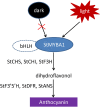Transcriptome analysis provides StMYBA1 gene that regulates potato anthocyanin biosynthesis by activating structural genes
- PMID: 36743487
- PMCID: PMC9895859
- DOI: 10.3389/fpls.2023.1087121
Transcriptome analysis provides StMYBA1 gene that regulates potato anthocyanin biosynthesis by activating structural genes
Abstract
Anthocyanin biosynthesis is affected by light, temperature, and other environmental factors. The regulation mode of light on anthocyanin synthesis in apple, pear, tomato and other species has been reported, while not clear in potato. In this study, potato RM-210 tubers whose peel will turn purple gradually after exposure to light were selected. Transcriptome analysis was performed on RM-210 tubers during anthocyanin accumulation. The expression of StMYBA1 gene continued to increase during the anthocyanin accumulation in RM-210 tubers. Moreover, co-expression cluster analysis of differentially expressed genes showed that the expression patterns of StMYBA1 gene were highly correlated with structural genes CHS and CHI. The promoter activity of StMYBA1 was significantly higher in light conditions, and StMYBA1 could activate the promoter activity of structural genes StCHS, StCHI, and StF3H. Further gene function analysis found that overexpression of StMYBA1 gene could promote anthocyanin accumulation and structural gene expression in potato leaves. These results demonstrated that StMYBA1 gene promoted potato anthocyanin biosynthesis by activating the expression of structural genes under light conditions. These findings provide a theoretical basis and genetic resources for the regulatory mechanism of potato anthocyanin synthesis.
Keywords: StMYBA1; anthocyanin biosynthesis; light-induced; potato; transcriptional activation.
Copyright © 2023 Zhao, Zhang, Liu, Zhao, Hu, Liu, Lin, Song and He.
Conflict of interest statement
The authors declare that the research was conducted in the absence of any commercial or financial relationships that could be construed as a potential conflict of interest.
Figures







Similar articles
-
Comprehensive metabolomics and transcriptomics analysis reveal the regulatory mechanism of StHY5 on anthocyanin accumulation in potato tubers.Plant Sci. 2025 Jul;356:112500. doi: 10.1016/j.plantsci.2025.112500. Epub 2025 Apr 7. Plant Sci. 2025. PMID: 40204193
-
StWRKY13 promotes anthocyanin biosynthesis in potato (Solanum tuberosum) tubers.Funct Plant Biol. 2021 Dec;49(1):102-114. doi: 10.1071/FP21109. Funct Plant Biol. 2021. PMID: 34794538
-
Genetic control of anthocyanin pigmentation of potato tissues.BMC Genet. 2019 Mar 18;20(Suppl 1):27. doi: 10.1186/s12863-019-0728-x. BMC Genet. 2019. PMID: 30885125 Free PMC article.
-
Functional diversification of the potato R2R3 MYB anthocyanin activators AN1, MYBA1, and MYB113 and their interaction with basic helix-loop-helix cofactors.J Exp Bot. 2016 Apr;67(8):2159-76. doi: 10.1093/jxb/erw014. Epub 2016 Feb 16. J Exp Bot. 2016. PMID: 26884602 Free PMC article.
-
Regulatory Mechanisms of Anthocyanin Biosynthesis in Apple and Pear.Int J Mol Sci. 2021 Aug 6;22(16):8441. doi: 10.3390/ijms22168441. Int J Mol Sci. 2021. PMID: 34445149 Free PMC article. Review.
Cited by
-
Systematic analysis of potato MYB family genes and their potential functions in anthocyanin biosynthesis.Sci Rep. 2025 Aug 1;15(1):28113. doi: 10.1038/s41598-025-13284-w. Sci Rep. 2025. PMID: 40750981 Free PMC article.
-
Integrative metabolomic and transcriptomic analysis provides insight into the mechanism of pigmentation in potato tuber eyes.BMC Plant Biol. 2025 Aug 30;25(1):1164. doi: 10.1186/s12870-025-07206-1. BMC Plant Biol. 2025. PMID: 40885937 Free PMC article.
-
Study on the dynamics of fruits color related genes and metabolites during the fruit development of Zanthoxylum bungeanum 'Hanyuan'.BMC Plant Biol. 2025 Jul 26;25(1):960. doi: 10.1186/s12870-025-06962-4. BMC Plant Biol. 2025. PMID: 40713503 Free PMC article.
-
Two tandem R2R3 MYB transcription factor genes cooperatively regulate anthocyanin accumulation in potato tuber flesh.Plant Biotechnol J. 2025 May;23(5):1521-1534. doi: 10.1111/pbi.14602. Epub 2025 Jan 30. Plant Biotechnol J. 2025. PMID: 39887502 Free PMC article.
-
Enhanced UV-B Radiation in Potato Stems and Leaves Promotes the Accumulation of Anthocyanins in Tubers.Curr Issues Mol Biol. 2023 Dec 11;45(12):9943-9960. doi: 10.3390/cimb45120621. Curr Issues Mol Biol. 2023. PMID: 38132467 Free PMC article.
References
LinkOut - more resources
Full Text Sources

